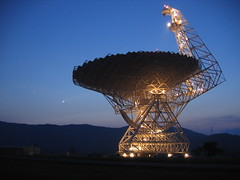
How do we find new pulsars? Well, there are a few places we know pulsars are likely to be - globular clusters, supernova remnants, X-ray binaries - but for the most part we just need to look at lots of sky. This isn't really feasible in X-rays - which you can only observe from satellites, on which time is precious - and apart from the exciting new gamma-ray results from Fermi, the only frequency range at which you can reasonably hope to find pulsars is the radio. So we more or less need to run a big radio survey that looks at lots of sky, one little patch at a time. But how do you get time on a multimillion-dollar telescope to look at sky where there's probably nothing?
Sometimes you can make a good science case for doing a survey. The most successful pulsar survey, the Parkes Multibeam survey, did this: they had a new multibeam receiver that would drastically improve the rate at which they could survey sky, so it was clear that time spent looking for pulsars would pay off. And it did, handsomely; they discovered over a thousand new pulsars.
More often, though, there are more pressing projects fighting for telescope time. So pulsar surveys need to come up with some other way to get time. The GBT 350 MHz drift scan survey took a clever approach: we were able to use time the telescope wasn't able to be used for anything else.
The GBT is an amazing machine, but with seven million kilograms running back and forth constantly, the azimuth track recently started to wear out. So the summer of 2007 was spent replacing the track. During this time, obviously the telescope couldn't move in azimuth without risking falling off the end of the track, so it couldn't follow sources as the Earth turned. But the receivers were all working fine, and the telescope could move in elevation just fine. So the people behind the drift scan survey pointed out that if they could simply use the receivers during the repairs, recording the sky as it rolled past, they could get useful data during the summer. This made good sense to the telescope access committee, so they were given the time.
The final arrangement was that the workers would work four twelve-hour days a week, during which time no data would be taken (arc welders are not conducive to good radio reception anyway). The rest of the time was devoted to the survey, which would be allowed to move the telescope in elevation twice a day. The survey used a relatively low frequency, 350 MHz, so that the beam would be big enough for any given piece of sky to spend about two minutes in view of the telescope.
Once the survey was set up, all we needed to do (I say we because it was at about this point that I got involved) was move the dish once a day, start the data recorders, and deal with the data. Dealing with the data was more involved than it sounds, because the data came in at a rate of about 90 GB/hour. So leaving analysis aside for the moment, we filled a couple of 800 GB disks a day, and somebody had to move all the data onto them and box them up for shipping to the various universities that would analyze the data. So when I went down to the telescope to observe as part of the survey, what I actually did was run a couple of scripts a day and shuffle disks.
In the end, the survey covered roughly a third of the celestial sphere, producing 134 TB of data. We're still analyzing the data - maybe only a quarter of it has actually been processed at this point, a year and a half later - but we've already found a number of new pulsars, some of them fascinating. So I think there are worse things the GBT could have done with those two months of track repair.









No comments:
Post a Comment